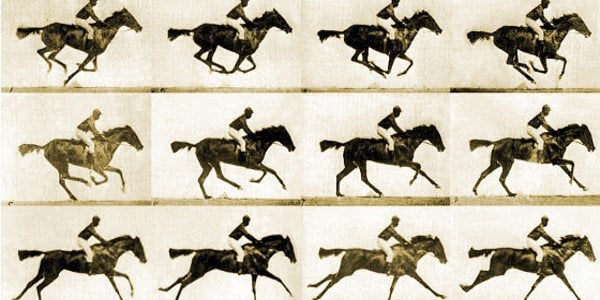The Phi Phenomenon: The Optical Illusion Your Brain Creates


Written and verified by the psychologist Valeria Sabater
The phi phenomenon (φ) is an optical illusion that our brain generates by making us believe that a fixed figure is in motion. The Gestalt school defined and coined this term in 1912. This, in turn, helped to demonstrate an important concept, that perception goes beyond our senses, and beyond what we see or feel. In reality, it’s merely something that our brain interprets.
The subject is undoubtedly much more interesting than it may seem at first. All of us are struck by these types of images, where striking figures of many different shapes and colors seem to tremble, move, or oscillate before our eyes. Knowing that this movement isn’t real is a bit of a shock that forces us to question several things.
Your first reaction when you realize that the perceived stimulus doesn’t correspond to the real stimulus is that something is wrong with you. Is there a problem with your senses? Is it a vision problem? Not at all! As far as the phi phenomenon and optical illusions are concerned, everything’s fine with you.
The secret lives of the brain
However, as the American neuroscientist David M. Eagleman, author of books such as Incognito, the Secret Lives of the Brain, points out, the first lesson we should learn about our senses is to not trust them. Just because you see something with your eyes doesn’t mean by any stretch of the imagination that it really exists.
The brain interprets, constructs, reconstructs, invents, and introduces axioms into your mind just to try to make some sense out of what it perceives when, for example, there are flaws or gaps in what it’s seeing through the eyes. This kind of discovery, in fact, was key to the development of the Gestalt theories.
“The whole is greater than the sum of its parts.”
-Max Wertheimer-

The phi phenomenon (φ), the pillar of Gestalt
It was Max Wertheimer (1880-1943), founder of the Gestalt School, who first described the so-called phi phenomenon in the field of science. He did so in a study entitled “Experimental studies on the perception of motion” (1912), in which he laid the foundations of the psychology of perception.
Thus, as in many discoveries, chance seemed to play a part. Dr. Wertheimer happened to find a stroboscope in a train station. After this curious finding, he started to wonder what created this fascinating phenomenon.
He knew that that set of geometric figures wasn’t in motion. However, his eyes told him that it was. He called this fact the ‘φ phenomenon’, to distinguish it from β (beta), where a stimulus does have a real and logical capacity to move.
Something was going on in these figures, and Dr. Wertheimer wanted to understand what produced it.
The phi phenomenon and false movement, a brain error?
The phi phenomenon differs in several ways from classic optical illusions. To begin with, what we generally see is a succession of similar figures. They’re unmoving images, but if they’re reproduced before our eyes one by one, and at a certain speed, you’ll have the sensation that they’re moving, when, in fact, they aren’t.
- Max Wertheimer demonstrated that, if we show a succession of static images at a specific speed, our brain interprets it as something that’s moving.
- This phenomenon is, in turn, related to retinal persistence. This concept is based on the idea that images remain “imprinted” on our retina for a small fragment of a second. If we pass many images before the human eye very quickly, the brain won’t be able to isolate one figure from another.
- This causes the brain to end up interpreting (erroneously) that it’s the same moving object.
We should note that this research by Max Wertheimer and his theory of the phi phenomenon contributed to the development of cinema, with the classic frames following one after the other. In fact, it was Hugo Münstenberg who became interested in this idea and fleshed it out in 1916.

The phi phenomenon, the starting point for the Gestalt School
It’s important to note that Max Wertheimer’s phi phenomenon wasn’t an innovation that can be credited to the world of scientific psychology. In fact, this type of perceptual experience was already known within the field of photography. One of the best-known exponents was the British photographer Eadweard Muybridge (1830-1904).
His work was groundbreaking for its time. It was 1878, and Muybridge had already invented what he called chronophotography. One of his best-known works was to photograph the movements of a horse and jockey during a race by using 24 cameras lined up on the track.
After obtaining and developing the images, he showed that reproducing them at a certain speed generated real movement.
While this phenomenon wasn’t anything new for some, Wertheimer’s work was an effect that changed everything regarding the area of Gestalt. We can’t forget that this school of psychology laid the foundations for the study of sensation and perception. For theorists such as Wertheimer himself, as well as Wolfgang Kohler or Kurt Koffka, what we perceive aren’t isolated stimuli.

Interpretative logic
In reality, the brain always tends to group everything we see and to create a whole, governed by a sense of coherence and interpretative logic. Hence, as we’ve seen, we choose to think that this succession of images aren’t isolated figures, but actually the same object in movement. Understanding it in this way saves effort and is easier for our brain.
However, the problem here is that it simply isn’t real. Nevertheless, as neuroscientist David M. Eagleman says, it’s a good idea to not trust everything that our brain makes us believe.
All cited sources were thoroughly reviewed by our team to ensure their quality, reliability, currency, and validity. The bibliography of this article was considered reliable and of academic or scientific accuracy.
- Hartmann, George Wilfried. 2006. Psicología de la Gestalt: una encuesta de hechos y principios . Kessinger Publishing. ISBN 142545285X
- Robinson, JO 1998. La psicología de la ilusión visual . Publicaciones de Dover. ISBN 978-0486404493 .
- Schwartz, Steven H. 2004. Percepción visual . McGraw-Hill Medical. ISBN 0071411879
- Steinman, RM, Pizlo, Z., y Pizlo, FJ (2000). Phi no es beta, y por eso el descubrimiento de Wertheimer lanzó la revolución Gestalt. Investigación de la visión . https://doi.org/10.1016/S0042-6989(00)00086-9
This text is provided for informational purposes only and does not replace consultation with a professional. If in doubt, consult your specialist.








